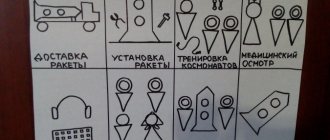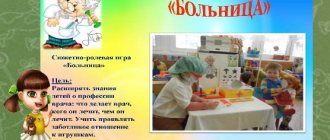At a very early age, from about two years old, a person begins to discover the unfamiliar vast world of relationships that exist between people. He strives to be actively involved in the activities of the adults living next to him and in the world of those things that are not yet available to him. And he does this through play, “make-believe”, turning an imaginary steering wheel, playing the driver of a car, and growls, imagining that he is a terrible tiger. And the girl plays mother, rocking a doll.
Role-playing games for children 3-4 years old.
The first role-playing games.
When a small child gets a little older, he begins to understand that he is capable of independent actions, like all adults. From that moment on, he begins to imitate all adults. This is how the first role-playing games for children 2-3 years old were born.
If the baby has experienced any strong impression, he strives to reproduce it, inventing a role-playing game and imagining himself as anyone. If you take a train ride with him even for a short time, the baby will play with the train with the carriages for a long time and puff hard, getting into character. And if you take him to the zoo, he will play, imagining himself as an animal that he especially remembers.
The child always has some toys at his disposal that depict objects from the adult world - cars, dishes, furniture. The child learns to use them, drives a car, irons them. If the baby does not have enough items to replace the real ones, he can easily find replacements for them. For example, if his car doesn’t have a steering wheel, he uses a saucepan lid.
Substitute items.
A substitute object is an important phenomenon in the development of a child’s thinking, a support for memorizing something. Many children collect various “garbage” according to their mother - pebbles, candy wrappers, pieces of iron. Under no circumstances should you throw away this collection; as a last resort, allocate a cardboard box for it. The child actively uses such little things in games, endowing them with various properties. Naturally, in your imagination.
It was noted that real creative abilities develop to a much greater extent in children who play with such substitute objects, and not in those who played with Lego constructors. And when a child stops playing with a substitute object, he simply moves into the sphere of imaginary things that exist in his inner space. By inventing different roles, a child learns to see an object from all sides, and, therefore, learns to have several points of view.
Story games for children 3-4 years old.
For a child, role-playing is the most important activity, trying on the functions of adult life, learning to interact with adults and peers. Even when the baby draws, he plays, coming up with the plot that he is trying to depict. If a child is given toys and left alone with them, he will find something to do that will captivate him. But it is desirable that an adult take part in the game, using it as a technique for achieving certain pedagogical goals.
The meaning of the game for a preschooler
In the game, the child practices communication skills
. The preschool period is the most important time for personality development. It is during these years that the baby receives his first knowledge about the life that surrounds him, he begins to develop his own opinion on what is happening, a certain attitude towards people and events, habits and behavior skills are formed, which forms the basis of his character. Much of the above is most often formed through play. It is through play that a child gains knowledge and develops communication skills, forms a worldview, expands his cognitive sphere of activity, and develops dexterity and discipline. Thus, the game becomes the best way for a preschooler to absorb information and social experience.
Role-playing games are of great importance for the development of a preschool child as a person.
“Role-playing games are games of a collective nature that develop children’s ability to communicate with peers.”
From about the age of three, role-playing games occupy a major place in the life of a younger preschooler. It is in this area that the child’s personality develops, the development of his cognitive processes is activated, and the foundations are laid for mastering new, more complex types of activities. While playing, preschoolers reflect in the roles they try on themselves everything they see around them: events, adult behavior patterns, etc. Participation in role-playing games allows the child to feel like a part of the children's team, to be critical of themselves and people.
Story games for children 2-3 years old and their goals.
When taking part in games with their baby, parents should understand that in this way they contribute to the achievement of some important goals:
- Nurturing a child's personality traits.
The basic concepts of what is good and what is bad, what is good and what is evil, are laid down during the game. At the same time, he understands without much emphasis that it is better to be polite than rude, modest than impudent, generous than greedy. - Socialization gradually manifests itself in games.
The baby learns to communicate with parents and other children, to be friends with them. He can learn to defend his own opinion. - Success in play lays the foundation for a child’s self-esteem.
He gains confidence in his abilities - the most important quality necessary in life. - If the game is active, it contributes to the physical development of the child.
He learns to walk and run, work with various objects, becomes stronger and more resilient. - Fine motor skills, precise movements used in play, are extremely important
for the harmonious development of a child, since they are directly related to the development of correct speech. - Finally, story-based games for children 2-3 years old develop the child’s attention, memory, imaginative thinking and imagination
, and train his psyche.
Story-based role-playing games for children 3-4.
Role-playing games for children 4-5 years old
Play actions at 4-5 years old already have a clear role-playing character, imitation is more noticeable. The roles are announced to the children, but they can change as the game progresses. If at an early age children were offered chains of one or two actions, now they can reach up to 4 actions, in which the children themselves control the game situation.
Salon
Purpose of the game: Introducing children to the profession of a hairdresser, building the right relationships, and expanding their vocabulary.
What you will need: For hairdressers you will need robes, tools (comb, hair dryer, hairpins, elastic bands, bottles, etc.), for clients - capes and a chair.
The game can take place with dolls or between children, the third option is combined. After knocking on the door, the doll Masha comes into the hall. She asks the guys if they have a comb, otherwise their hair is completely frayed, the braid is unraveled - she would like to get help. The children offer the doll to go to the hairdresser, but at the same time a clarification is made: there are women's and men's rooms, additional services of manicure, pedicure, and shaving. Hairdressers stand at their work stations and take up their tools. More and more clients begin to come and leave their reviews. The children learn through the process of imitation what concepts exist in hairdressing and what the responsibilities of specialists are.
School
Purpose of the game: Children’s ideas about school, the principle of obtaining and assessing knowledge, the emergence in them of a desire to learn, respect for the work of teachers, and replenishment of vocabulary are clarified.
You will need: School supplies (pens, notebooks, pencils, etc.), blackboard, chalk, pointer, books as textbooks, alphabet.
To begin with, the teacher explains what school is, what happens there, what students and teachers do. One teacher is selected from among the children, who gives the task to the others - everyone completes it at the same time. Next comes another lesson, a new teacher is chosen. The following subjects can be used: mathematics, singing, physical education, native language, art and others. A good solution would be to even create a schedule. The content of the tasks is chosen by the children.
Zoo
Purpose of the game: Development of children's knowledge about life, habits, nutrition, habitat of various animals, nurturing in them a humane attitude towards our smaller brothers.
You will need: Animals from toys that are familiar and understandable to children, improvised cages, money, tickets (can be cut out of paper and signed).
The teacher invites all his students to the zoo and sits down at the “cash desk”. Children hand over sold tickets to the same teacher or selected controller. Upon entering the zoo, they talk about the animals they saw, create a complete picture of their existing knowledge, and an adult teaches them important principles of caring for animals.
The plot of the role-playing game and its content.
The plot of a role-playing game should not be confused with its content. The plot is what the baby is trying to reproduce in the game, he can play in the hospital, in school or family, in the store: in everything that he sees around and what he encounters in real life.
A game with the same plot can have completely different content, reflecting the behavior of people and the very meaning of their activities. For example, playing family, taking on the functions of a mother, one girl will babysit the children, and the other will scold and punish them, one will be a housewife who cooks and washes all the time, and the other may be a fashionista trying on outfits in front of the mirror.
The content of the game largely depends on the age of the child. The youngest can play cooking dinner, but no one will eat it. A middle-aged preschooler will already feed other participants in the game or dolls, that is, he will perform actions not for the sake of the actions themselves, but to determine relationships with his playmates. While older preschoolers are playing, they pay attention to whether they are acting correctly in one role or another.
Stages of introducing young children to role-playing games
At an early age, children gradually master role-playing games. Mastering a role-playing game takes place in several successive stages.
Stages of developing role-playing play in young children:
Stage one . Introduction to role-playing games occurs within the framework of object-based play activities created by an adult, in which a variety of toys, objects and materials are used.
Young children are still learning to play. In this connection, the task of an adult is to teach a child to play with toys, to master actions and manipulations with them. All this is carried out in joint activity with an adult, through examination of the qualities and properties of objects and toys. When introducing a child to toys, an adult says its name, what actions can be performed with it, what roles the toy can be assigned. The correct selection of toys is important. First of all, a toy should encourage the child to develop.
Finished works on a similar topic
- Course work Features of role-playing games at an early age 440 rub.
- Abstract Features of role-playing games at an early age 230 rub.
- Test work Features of role-playing games at an early age 230 rub.
Receive completed work or specialist advice on your educational project Find out the cost
Stage two . Development of independent play activity, which manifests itself in display play - the child’s actions are aimed at determining the main properties of toys and objects, as well as achieving specific results with their help.
At this stage, the adult’s task is not just to introduce the child to objects and toys by saying their names, it is necessary to draw the children’s attention to their intended purpose. In addition, it is necessary to gradually familiarize children with the properties of toys and objects, external signs and features. For the successful development of role-playing play, it is very important to teach the child to transfer his existing knowledge from one subject to another, as well as generalize his own actions.
Stage three . The direct development of role-playing play (the end of the first year of life - the beginning of the second year) - the formation of plot-representative play occurs in children, during which children are already able to actively display their own impressions received in everyday activities.
At this stage, the adult’s task is to teach children to reflect various life situations that are familiar to children from personal experience within the framework of the game. It is also important for this stage to have the necessary toys and objects that can satisfy the needs of children in acting out various situations (dolls, doll furniture, dishes, cars, various tools, etc.). An adult sets a conditional game goal for the child, which he achieves through a variety of game means and methods, thereby obtaining the necessary imaginary result.
Too lazy to read?
Ask a question to the experts and get an answer within 15 minutes!
Ask a Question
How to teach your baby to play.
A small child himself cannot invent a role-playing game, although he easily learns such games from those familiar with them - from older children or from parents. However, not all kids are willing to engage in role-playing games - some may be too shy and constrained and prefer to play sports games or play on a computer screen. But role-playing games for children 3-4 years old are extremely important for their harmonious development.
Story games for children 2-3 years old.
In this case, parents need to help their children:
- Remember your own past, how you played as a child, come up with a few simple plots and start playing with your child yourself.
- Use another child as an intermediary - an older brother or sister, a little neighbor who willingly plays such games. It is only important that this intermediary is not so active that it turns your child off from the play action.
- Try to let the child come up with the circumstances of the game himself, even new words. Offer a masquerade to a shy child - it may be important for him that no one will see his face behind the mask. If there are several participants in the game, make sure that your child is interested, first offer him minor roles, and then more significant ones, so that the other participants do not suppress him.
- Use fairy tales, refer to them in difficult situations, act as your favorite fairy-tale hero would do. Please note that children under 3-5 years old prefer to use fairy tales about animals in games, while older children already play at people - princes, princesses.
- You can, while doing your household chores, involve your kids in similar games. Mom bakes pies - and her daughter will happily bake plasticine pies for dolls.







